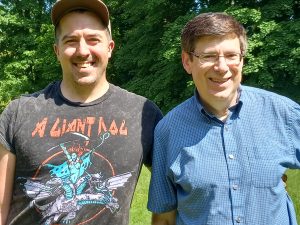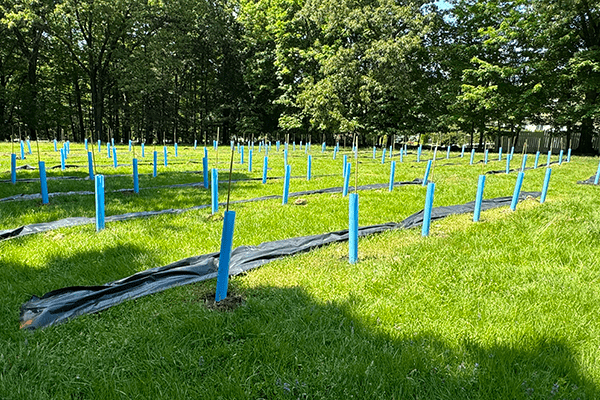|
RCBJ-Audible (Listen For Free)
|
Marvin Baum Is Bringing Former Salowey Farm In New City Back To Life With Organic Viticulture
By Tina Traster
It’s the kind of spring day that storybooks are made of. A fawn is nestled in the fragrant grass. Pollen is dancing in the air. The warmth of the sun extracts the aromas of fast-growing vegetation.
A landscaper in rubber boots is on his knees tending the soil, preparing rows of grape vines. This is not Napa Valley or Northport. This is New City, where an oenophile entrepreneur is banking on the comeback of the historic High Tor Vineyards on his recently purchased, three-acre property off Little Tor Road.

Marvin Baum, an event promoter, environmentalist, and visionary bought the parcel with two historic houses and a world of potential in 2022. From 1960 to 1990, the land, with two houses, was the site of a little-known, non-licensed vineyard known as Salowey Winery.
But nearby, High Tor Vineyards, which has been incorporated as open space into High Tor State Park, operated for four decades until 1989 and played an important role in Hudson Valley winemaking.
“I’m planning on bringing back the High Tor name that many people in Rockland and the New York wine industry still remember,” said Baum, a newly minted gentleman farmer, while we chatted at the young vineyard where a landscaper was planting 200 vines. Another 100 are still in a nursery. “My goal is to be as innovative as possible in the spirit of both the original High Tor Vineyards and the former Salowey Winery.” Baum also plans to resurrect bee keeping on the property.
Rockland County is better known for growing apples and fruit trees on farms like Dr. Davies and Concklins, but Baum and a handful of others are toiling to resurrect vineyards. Joanne Clemente, on Old Stone Road in Valley Cottage, has been growing non-organic grapes for a year.
In mid-19th century, the lower Hudson Valley was one of the richest grape-growing and wine-making regions in America and a home for viticultural science. Nyack, with many backyard growers, was a source of grapes for New York City and for wine makers.
California, the Ohio River Valley, Ulster County, and the Finger Lakes lay claim to being America’s first wine making regions, though the longest-running winery is the Brotherhood Winery in Orange County, that dates to 1839.
By the start of the Civil War, more than 20,000 vines were growing in the Nyacks. By the Civil War, Upper Nyack, with farms ranging from 30 to 170 acres, had replaced cash grain crops with grapes and fruit trees. Until 1890, Garret Onderdonk had a vineyard in Central Nyack (then called West Nyack). In 1949, a winery opened on the southerly slopes of High Tor Mountain, bringing back briefly the era of Nyack’s vineyards.
Everett Summer Crosby, a writer and former broadcaster at Voice of America during World War II, put Hudson Valley winemaking on the map with High Tor Vineyards. (HarperCollins published his book “The Vintage Years: The Story of High Tor Vineyards in 1973.) Crosby cultivated the highest peak in Rockland County on a 53-acre tract for four decades. In 1992, a developer bought the property and received preliminary approval for the construction of 20 homes. A local group named West Branch Conservation Association, which sought to preserve the mountain in its undeveloped state, sued the builder and Clarkstown to prevent the construction. In 1995, the property was purchased for an undisclosed sum by Scenic Hudson Land Trust Inc., a Poughkeepsie-based conservation group that has kept the site wild.
The land of High Tor was granted to the Van Orden family by King George III. Grapes had been growing on the property dating back to the 18th century.
Crosby bought the High Tor site with its historic Van Orden House in 1950 to prove that he could produce quality grapes and wines just 20 miles north of the George Washington Bridge. “His products stood the test of time as he marketed as much of his Rockland White, Rockland Red and Rockland Rose as he could produce,” reported the New York Times. According to American wine historian Leon Adams, High Tor was “for a quarter of a century was the most famous small winegrowing estate in eastern America.”
Stephen Casscles, a viticulture expert, has written: before the arrival of the French-American grape varieties to the Hudson Valley in the 1950s, there were only four wineries in the valley that produced sweet table wines, dessert wines and sparkling wines made from labrusca grape varieties such as Bacchus, Catawba, Concord, Delaware, Dutchess, Iona, and Niagara. After the introductions of French-American hybrids, there was an explosion of wineries growing these grape varieties.
Families like the Saloweys, who were hobbyists, made dandelion and root wines in their basements and sold bottles to friends and families.
“Stas Salowey was a chemical engineer who worked for a sugar company in Yonkers,” said Baum. “He understood that everything about wine making relates to understanding sugars.”
Baum said viticulture has been a lifelong passion.
“When I saw the Salowey property, it was overgrown, raccoons everywhere, there were wine bottles covered with layers of dust,” said Baum. “I remembered High Tor Vineyards and I thought this could be used for farming again.”
In his event promotion business, Baum has worked for years with wineries and other craft businesses. Over the past couple of years, he has been educating himself on grape growing and viticulture, particularly on organic farming, by working with experts like Casscles and Cornell University and vineyards around the country.
While one of the two houses on the property is in good, rentable condition, the other, a Cape Cod made of Haverstraw brick, needed top to bottom renovation.
For now, Baum has 300 Virginia Cayuga White Grape vines in the ground. He says it will take roughly three years to see the first harvest. The renaissance farmer has invested more than a million in the property and preparation for the houses, land, and vineyards. He’s gearing up for both growing, production, and bottling.
Whether he will be able to have small-scale on-site winery agritourism remains a question as Clarkstown prepares to pass a local law that will limit such operations to farm sites of at least ten acres. The new High Tor Winery would need a variance to serve wine or hold events. The town is set to vote on the local law on June 25th.
““Farming is not something of the past,” said Baum. “It can be something of the future. New York has lost 10 percent of its farmers, and many remaining are past the age of retirement. This is a lifelong dream.”











